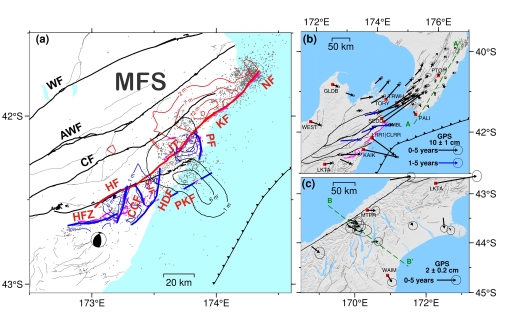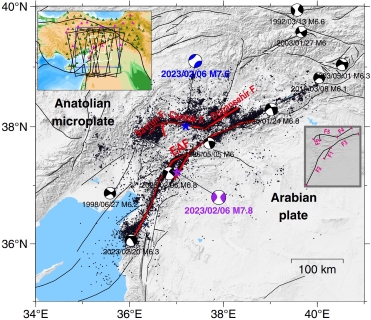


We have constructed a three-dimensional finite element model to investigate the viscoelastic postseismic deformation of the 2018 Mw7.9 Kodiak earthquake. We derived the first 2-year postseismic GPS observations to constrain the afterslip and upper mantle rheology in the south-central Alaska. The upper mantle is separated into the mantle wedge and oceanic upper mantle topped by an 80-km thick asthenosphere layer by the subducting slab. Results show that afterslip generally takes place in areas adjacent to the rupture zone and have a smaller magnitude of a few tens of millimeters. The steady-state viscosities of the asthenosphere and mantle wedge are determined to be in a ra
Read More
Understanding postseismic processes following the 2016 Mw 7.8 Kaikōura earthquake remains challenging due to the time‐dependent afterslip over the complex forearc system including crustal faults and megathrust, and the viscoelastic relaxation of the upper mantle. How the 2016 Mw 7.8 Kaikōura crustal earthquake interacts with the megathrust has yet to be better understood. Here we have derived the first 5‐year postseismic displacements from Global Positioning System (GPS) time series of 75 stations to study postseismic processes through a three‐dimensional viscoelastic finite element model. The optimal steady state viscosities of the crustal shear zone, megathrust sh
Read More
In this work, we aim to study coseismic kinematic and slip distribution of the 2023 Kahramanmaraş earthquake sequence. We also investigate postseismic deformation following the earthquake doublet to study upper mantle rheology and afterslip evolution. Part of the work was published on SRL. Wang, Kai, Xu, Xiaohua, Hu, Yan (2024). Kinematics of the 2023 Kahramanmaraş Earthquake Doublet: Biased Near‐Fault Data and Shallow Slip Deficit. Seismological Research Letters, 2024. https://doi.org/10.1785/0220240062
Read MoreCopyright © Geodynamics Research Center,USTC/DSEL. All Rights Reserved.